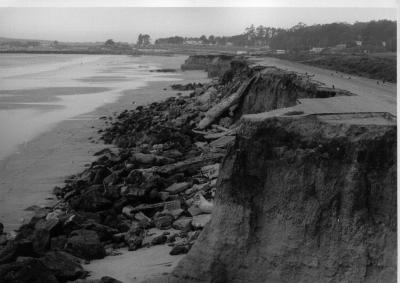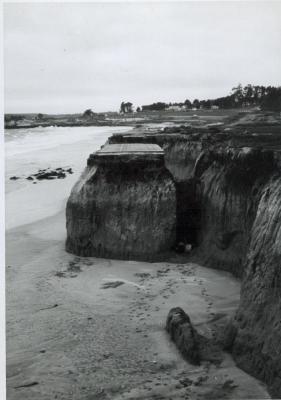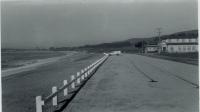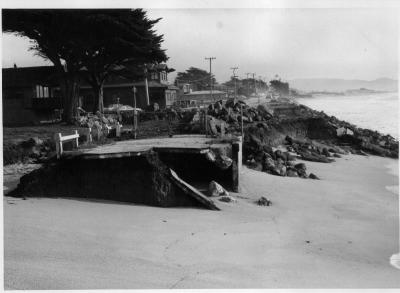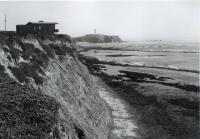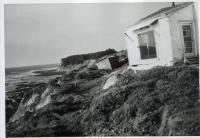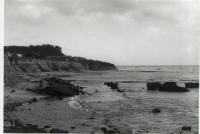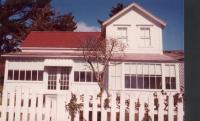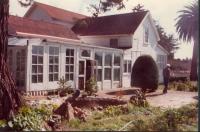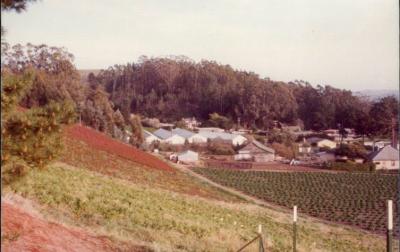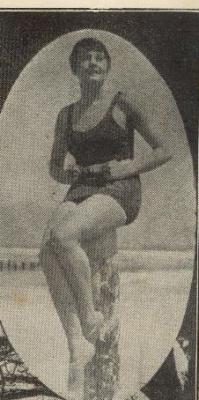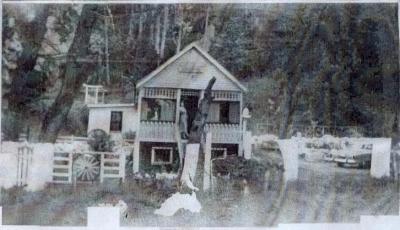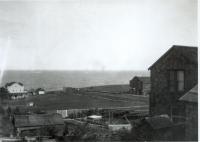El Granada-Miramar
1971: Ken LaJoie Collection: Coastside Cliffs
1971: Ken LaJoie Collection: Coastside Cliffs
The Mullen Farmhouse
When I dropped in on Tom Clyne at the historic Mullen Farmhouse in east Miramar in 1977, the 84-year-old retired bookkeeper told me he had inherited the property from Clara Mullen.
Wow, I thought. What a great property. The Mullen Farmhouse stood at the far end of a dreamy country lane, itâs white paned windows barely visible from a favorite nursery of mine specializing in apple trees.
Clara–the last surviving Coastside Mullen– died of a heart attack in 1971. Tom did the books.
Was there a romantic link between the couple? I doubt it. Clara Mullen was two decades older than Tom Clyne. But although born in San Francisco, Tom Clyne spent the latter part of his days living alone in the Mullen Farmhouse, leaving only to drive to Pacifica where he swam laps in the high school pool.
The old farmhouse was originally home to the Irishman John Mullen, his wife, and eight children, four boys and four girls.
There was Ned and Bill and Annie and Clara and Tom Clyne couldnât remember the names of the other two boys.
I already knew the background of the property when I visited Tom in the 1970s.
A century earlier the Pacific Steamship Company had hired John Mullen to run Amesport Wharf, today known as Miramarâand Tom added that Mullen purchased the beautiful property, within walking distance of Amesport, from the famous San Franciscan, Claus Spreckels, âthe sugar kingâ?.
Busy Amesport was a power point and John Mullen so famous that nearby Medio Creek was called âMullenâs Creekâ? by the locals. Memories of John Mullenâs presence hadnât faded much over the decades because I heard locals comfortably using âMullenâs Creekâ? in the 1970s.
In the Redwood City archives of the San Mateo County History Museum, Clara Mullen left us an anecdote about Amesport Wharf. She describes the tiny village of misfits and sea captains and deep sea divers as such a busy place that three small ships were loading and unloading supplies at the same time. Coal for heating was imported from far away England but the self-reliant Coastsiders planted fast growing eucalyptus trees and later cut them down for firewood.
Tom didnât change much inside or outside the old Mullen farmhouse, constructed entirely of redwood, and held together with square hand-cut nails–but he did like modern conveniences and installed electricity and plumbing. There was an outhouse but there also were two commodes (bowls) inside cabinets in the event you didnât make it to the outhouse in time.
Original furniture remained, chairs, a walnut bed frame and an antique secretary with hand carved handles. One entire room looked as it did 100 years earlier. I hope I get this right: throughout the house the walls were fashioned of âwood on woodâ?. In this one room I saw an old- fashioned wallpaper pattern. Tom explained that in order for the wallpaper to stick, a layer of cheesecloth was placed between the wood and the wallpaper.
The art on the walls was that of the easily recognizable local painter Galen Wolf, watercolors of Pillar Point, Devilâs Slide and the Hatch Mill that once stood south of Half Moon Bay. Also mounted on the wall was a special dinner plate, a reminder from the ill-fated T.F. Oakes, the iron ship that ran aground at the foot of Kelly Street in 1898.
I felt lucky to see the old Mullen Farmhouse . You donât get to do that often these days.
Before I left, Tom Clyne pointed out one more thing. Look closely at the white fence, he said. I saw a single red rose blooming. Look closer, he said, and youâll see a bullet hole. Just above the edge of the red petals, I saw it, the bullet hole.
Not long after the Palace Miramar had replaced the Amesport Wharf, one of the Miguelâs horses trespassed on the Mullenâs property, and John Mullenâs son, Bill, aimed at the animal but we donât know if the bullet hit its target.
But the small bullet hole in the fence, and all the possible stories you can imagine leading up to it, has fascinated me ever since.
Bathing Beauty Poses at Half Moon Bay
The Coastside’s One&Only “House of Doors”
When you used to drive west on Hwy 92âand if you knew the road well—youâd anticipate that sharp curve where the famous âHouse of Doorsâ? stood against a steep rock formation.
If you were with a friend whoâd never been to the Coastside before you might even point out the place, proudly, you know, like it was a secret local landmark.
And if it was late at night, and you were the only car on the highway, you might even swear you saw a ghost drifting across the roadâeverybody said it was Ann Howe ‘s ghost–she was the one most connected with the house which originally came from the 1915 San Francisco Panama Pacific Exposition. Saloon keeper Fred Nordholz bought it and re-assembled it on the spot where it stands. Ms. Howe, a native of Kentucky, who once owned a ranch house atop Twin Peaks in the City, was driving along Hwy 92 in 1947 when she saw the house and envisioned it as a tourist attraction, a museum filled with antiques–and she had to have it.
Most of the walls are actually doors and it is said the roof rested on the door tops for support. When Ann Howe lived there, between about 1947 and 1971 when she died, most of the single story house was crammed with silver, crystal, copper pieces, old crank telephones, 1893 calendars and a very old vacuum cleaner.
Outside stood ancient wagons and wheels of all kinds and a surrey with fringe on top–and there were cats with extra toes and a dog that climbed ladders.
Ms. Howe called it her hobby, and what a delight it must have been–but have you noticed that you canât see the âHouse of Doorsâ? from Hwy 92 these days?
If you squint really hard you can pick it out among the eucalyptus groveâbut the sighting is very brief and not satisfying at all.
I fear for the âHouse of Doorsâ?.
After I wrote a little post about Ann Howe who, besides being the owner of the “House of Doors” was also affiliated and honored by many Coastside organizations, I received the following email:
Ann Howe (NEWTON) – was my great aunt – her brothers also lived in Half Moon Bay/San Mateo area. She was originally from Fordsville, Kentucky. Her brothers, Edward Newton and Oscar L. Newton also lived in Half Moon Bay and all three are buried in the same cemetery. Other family member names from Edward’s family are his wife Evelyn, Gary, Dennis & Dianne (twins) and Susan.
Oscar was my paternal grandfather. I have been trying to contact some of the descendants of the NEWTON clan and haven’t had much luck. I made a trip to Half Moon Bay in 1997 just to look at the “House of Doors” one more time. The last time I was there; before 1997, I was 15 yrs. old and that was about 39 years ago. I couldn’t see very much of it but from what I did see, it appeared to be a lot smaller that I remembered.
Ann was a part of the San Franciscan history and I wished I could have known her better. I often wonder how she and her brothers ended up in California in 1928 and am envious of their apparent enthusiasm and desire for adventure.
My name is Patricia Nichols (NEWTON) and I live in Brownsburg, Indiana and will be retiring to Marrowbone, Kentucky in July. Just wanted to share a memory.
In case anyone from my family would like to contact me:
Patricia Nichols
10192 N. Co. Rd. 800 E.
Brownsburg, IN 46112
This address will change sometime this year probably around end of July ’06 and then it will be:
100 Nichols Rd.
Marrowbone, KY 42759
Email: Patricia Nichols: [email protected]
(Photos, courtesy Patricia Nichols)
Love the Coastside
Murder in Montara: Babes in the Woods Case: THE END
When the trial of alleged murderer Vorhes Newton opened at the Redwood City courthouse in October 1946, the heinous crime had slipped from the front pages of the newspapers.
Short summaries of the Newton murders—Vorhes was accused of killing his two little daughters and for the attempted murder of his wife, Lorraine, all found in a remote Montara canyon– appeared on the same page as the trials of convicted abortionists and the closings of illegal âabortion millsâ?. Was there a connection?
But before the prosecution and defense faced off in the Newton trial, 115 potential jurors were called to the Redwood City courthouse and after two-and-half days ânine housewives and three menâ? were selected to sit in the jury box.
To the press, both legal adversaries exuded optimism. Fred M. Wycoff, the prosecutor, who had worked the Newton case since it broke over the summer, believed his detective, Frank Marlowe– a name worthy of a mystery novel– had handed him a âhoney of a caseâ?.
His star witness, Wycoff announced, was to be Newtonâs 21-year-old wife, Lorraine.
Criminal Defense Attorney Leo R. Friedman, was just as famous for his ability to delay and delay as he was for changing his clientâs venues. On the behalf of Newton, he was asking the court to move the case from Redwood City to San Jose– and he revealed to reporters that his strategy would include the controversial Jeckyll and Hyde theory of dual personalities, backed up with psychiatric testimony, to explain the horrific actions of Vorhes Newton.
Newton had pleaded not guilty and not guilty by reason of insanity.
In his opening statement, Fred Wycoff fascinated the jury by linking the case with the popular 1946 movie, âThe Postman Always Ring Twiceâ?, starring gorgeous Lana Turner. Wycoff said the Newtons saw the film the night before the murders and claimed that Vorhes was influenced by Lana Turnerâs character, Cora Smith, who smashed a bottle over her husbandâs head. Newtonâs children were killed with a milk bottle found at the scene.
Wycoff also elaborated on what happened during the hours before the murders. He told the jury that Lorraine Newton had been pregnant when Vorhes drove her and the children to the Coastside where he suggested Lorraine have an abortion. When she balked, he beat his wife and threw her over a 12-foot embankment. Then he killed the children and attempted to bury them. Police caught up with Vorhes at Lake Tahoe where he claimed to have no memory of the crimes, adding that it wasnât in his nature to kill anyone.
Called to the witness stand were Vorhesâs sister and brother-in-law. Newton had borrowed their car to take his wife and children on the death ride and returned it later the same day looking as if nothing had happened. To the Petermans them he had always seemed a loving father and caring husband. They drove Vorhes to the train believing he was going to San Francisco to join Lorraine and the kids.
Everyone in the courtroom anticipated Lorraine Newtonâs damaging testimony. She had survived her husbandâs brutal attacks, suffering a miscarriage afterwards. Although most folks sympathized with her, she had her detractors, too. She was criticized for sounding âstrangely impersonalâ? and for ânot showing enough emotionâ?.
But Lorraine Newton never took the witness stand.
The trial had barely gotten started when shocking news paralyzed the courtroom: Vorhes Newton had hung himself in his cell on the third floor of the Redwood City jail.
There ensued a discussion of what to do next with the Prosecutor Wycoff suggesting the case be dismissed. Before that happened, Newton’s counsel, Leo Friedman made a statement, saying that his client told him repeatedly he had no memory of the events of the day of the murders–and that he had turned up evidence pointing as much to Newton’s innocence as guilt.
Wycoff said, “Newton is now before a greater Judge. He has left this vale of tears.”
After the trial was dismissed a few hours later, Lorraine Newton walked into the District Attorney’s office and said, in what tone we are not told: “I am sorry justice was not permitted to run its course.”
As the case was dismissed, another rumor was making the rounds: Supposedly Newton had said, “If I ever become convinced I did it, I’ll hang myself.”
$2 Mill Airport at Moss Beach
WWII WASP Searches for Summer of 1944
(Photo at right: Shirley Thackara in the PQ14 at the Moss Beach military airstrip)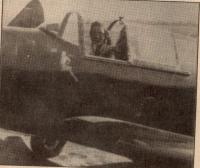
Former Air Force Service Pilot Shirley Thackara returned to the Coastside in 1993 to reclaim WWII memories of flying PQ14s, tiny planes, so tiny only one person could fit inside.
She flew the PQ14 out of a military airstrip in Moss Beach. Her scarey assignment three years after Pearl Harbor, she told me, âwas supposed to be very hush-hushâ?. What she did was tow targets behind the plane and military gunners on the ground practiced shooting at themâ pretty dangerous if they missed as stray bullets could do damage to both civilians and Shirley herself– which was why the training occurred on the remote Coastside.
But when Shirley came back to Moss Beach almost 50 years later she said she couldnât find anything she recognized.
The memories hid from her because the Coastside had grown up ,and the reminders swept away since the summer of 1944âwhen Shirley, a 5â11â? former Pan American Airways secretary– decided to turn in her manual typewriter and learn how to fly during WWII.
She trained at Otis Air Force Base in Massachusetts and after 200 hours of flight time she made the grade, became a member of the coveted Women Air Force Service Pilots (WASPS) and was assigned to Moss Beach where she bunked at the edge of the flight strip with fellow WASPS Mary Lee Leatherbee and Mildred Toner. Women flying military planes was groundbreaking.
Moss Beach was in the countryside but even more remote than Shirley Thackara expected. When she saw her new home, an abandoned farmhouse with curtainless windows, her response was ââ¦.it was so awful, it was funny. Everything in dark wood, showing signs of once having been a bird house, three rooms, kitchen with nothing but a sinkâand absolutely no furniture except three Army cots.â?
Parked outside what she dubbed âthe fishing shackâ? was Shirleyâs 1941 Mercury convertible. She recalled driving along the cliffs to Half Moon Bay, but she couldnât find the road in 1993. The âfishing shackâ? was gone, the military strip wasnât where she remembered it and even the road she had traveled had disappeared.
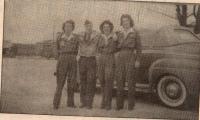 They flew the PQ14s at Moss Beach during WWII: L-R: WASPS Mildred Toner, Mary Lee Leatherbee, Shirley Thackara–with Army Air Force Lt. Nash.
They flew the PQ14s at Moss Beach during WWII: L-R: WASPS Mildred Toner, Mary Lee Leatherbee, Shirley Thackara–with Army Air Force Lt. Nash.
(all photos Shirley Thackara–and thanks to the Spanishtown Historical Society for the introduction to Shirley)

